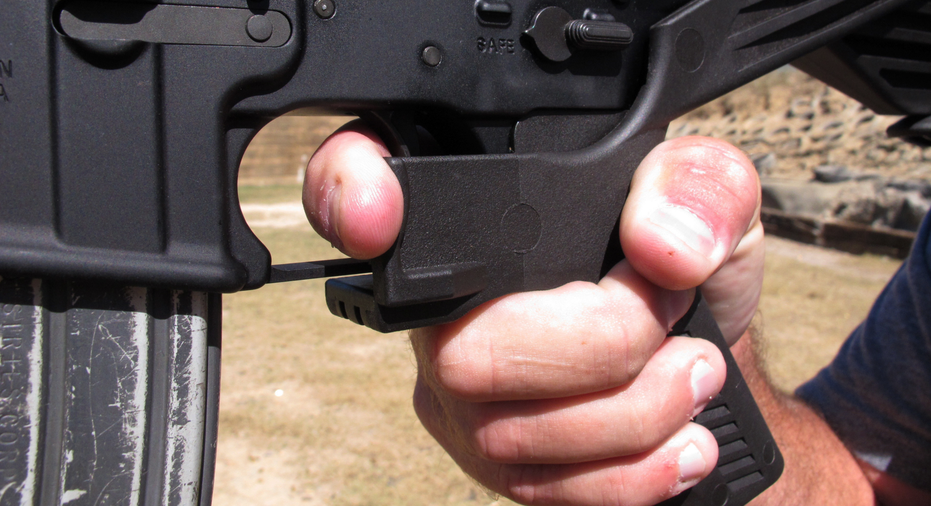'Bump stock' sales could spike after Las Vegas shooting

The Las Vegas gunman possessed a little-known device called a "bump stock" that was not widely sold — until now.
Originally created with the idea of making it easier for people with disabilities to shoot a gun, the attachments allow a semi-automatic rifle to mimic a fully automatic weapon by unleashing an entire large magazine in seconds. Now the deadliest mass shooting in modern U.S. history has drawn attention to the devices, which critics say flout federal restrictions on automatic guns.
The stocks have been around for less than a decade. The government gave its seal of approval to selling them in 2010 after concluding that they did not violate federal law.
The device basically replaces the gun's stock and pistol grip and causes the gun to buck back and forth, repeatedly "bumping" the trigger against the shooter's finger. Technically, that means the finger is pulling the trigger for each round fired, keeping the weapon a legal semi-automatic.
The rapid fire does not necessarily make the weapon any more lethal — much of that would depend on the type of ammunition used. But it does allow the person firing the weapon to get off more shots more quickly.
It's unclear how many have been sold. Listings for the devices had been seen on websites for Walmart (NYSE:WMT) and Cabela's (NYSE:CAB), two of the nation's largest gun retailers. But those listings were no longer on either company's website on Wednesday.
Walmart said in a statement that it pulled the devices after determining they violated a "prohibited items policy" and never should have been offered for sale. Cabela's did not return messages seeking comment.
The leading bump stock maker, Slide Fire, did not return messages seeking comment. But the Texas company's Facebook page is filled with videos extolling its features, including one in which a woman gushed, "It's so easy because once you slid it forward and leaned into it, it just fires." In another video, a man fires off 58 rounds to celebrate his 58th birthday in just 12 seconds.
Sales for firearms or specific accessories seem to jump after every high-profile shooting. That will likely happen again with bump stocks, said Dr. Garen Wintemute, director of the Violence Prevention Research Program at the University of California, Davis.
"People will go, 'Oh geez, I should get one of those.' The other is that people will be concerned about efforts to ban them," Wintemute said.
Manufacturers tout the stocks, some of which sell for less than $200, as offering a simple and affordable alternative to automatic weapons without the hassle of a rigorous background check and other restrictions.
Ed Turner, who owns Ed's Public Safety, a gun shop in Stockbridge, Georgia, said he's already seeing a run on bump stocks since the shooting. He said he would be surprised if he had sold two of them in the past decade, but now he's unable to find any available, even from wholesalers.
Jay Wallace, owner of Adventure Outdoors in Smyrna, Georgia, said soon after most of his customers buy one, "the newness wears off and they put it away and it stays in a closet."
While the stocks allow a gun to quickly spray bullets, gun experts say they also create such a jolt that accuracy is affected. That may not matter to gun owners who just want the thrill of shooting with one, or for those bent on destruction. Stephen Paddock, the 64-year-old gunman, fired hundreds of rounds indiscriminately from his 32nd-floor room at the Mandalay Bay Hotel and Casino on a music festival outside.
He had 23 guns in the room. Authorities found bump stocks attached to 12 of the weapons, Bureau of Alcohol, Tobacco and Firearms Special Agent in Charge Jill Schneider said.
At Paddock's home, authorities found 19 more guns, explosives and thousands of rounds of ammunition. Several pounds of ammonium nitrate, a fertilizer that can be turned into explosives, were in his car, authorities said.
The shooting renewed a push by some lawmakers to ban bump stocks. California Sen. Diane Feinstein, a Democrat, said the devices can enable a gun to fire 400 to 800 rounds per minute and "inflict absolute carnage."
Erich Pratt, executive director of Gun Owners of America, said the industry is prepared to have the devices scrutinized by lawmakers and gun-control advocates. That happens regularly after a major shooting. But he and others defended their use, suggesting it's unfair to go after firearms when other weapons — trucks and fertilizer, for example — aren't as quickly criticized after deadly attacks.
"Ultimately, when Congress ... looks at this, they'll start asking questions about why anybody needs this, and I think the answer is we have a Bill of Rights and not a Bill of Needs," Pratt said.